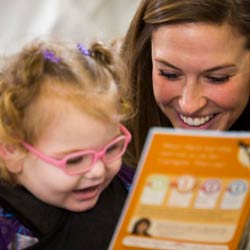 Research tells us that early experiences with books have an incredibly significant impact on a child’s language and learning. Many of us know that books are a great way for children to learn new vocabulary words and begin to learn about letters and words. Furthermore, book-sharing experiences early on can create positive feelings toward books. Think about it: your child is cuddled in your lap, with your full attention, interacting with you, his loving caregiver! The positive emotional experience promotes a love of book, one that can carry on into the school years and beyond. Here are some tips for making “book time” a fun time for toddlers:
Research tells us that early experiences with books have an incredibly significant impact on a child’s language and learning. Many of us know that books are a great way for children to learn new vocabulary words and begin to learn about letters and words. Furthermore, book-sharing experiences early on can create positive feelings toward books. Think about it: your child is cuddled in your lap, with your full attention, interacting with you, his loving caregiver! The positive emotional experience promotes a love of book, one that can carry on into the school years and beyond. Here are some tips for making “book time” a fun time for toddlers:
- Choose books that are visually simple. Look at the illustrations on the pages. Are they very busy with a lot of details? This might be too much visual information for a young child. I like starting out with board books that have a few pictures on each page, preferably brightly-colored photo-style pictures of objects that are familiar to a child. The “Bright Baby” series is a good example.
- Choose books with simple language. Young children respond best to books with few words, and better yet, repetition throughout the book. A favorite of mine is “Brown Bear, Brown Bear, What do you See?” by Eric Carle. The beautiful, brightly colored images on each page, combined with the simple, repetitive language, make it a great choice.
- Books whose words have a natural cadence or rhythm are enticing to children. For young children who might not be ready to attend to the words in a book, this rhythm or cadence can be an attractive quality. Try to read the book with this quality in your voice. Another favorite of mine is “Moo Baa La La La” by Sandra Boynton.
- There’s no need to ask a lot of questions. For some children, asking questions or trying to have them name pictures or repeat your words can turn the experience into a negative one. This is particularly true for children with delayed speech, language, and/or cognitive skills. It is perfectly okay for your child to remain silent! It is better to have the child engaged non-verbally than to pressure him/her into talking. How can you do this? Point out and name pictures. Instead of asking a question, rephrase it as a comment: “I wonder where the star is. Oh, I found it!”
- Follow your child’s lead. Name the pictures he or she points to. If your child is not yet pointing, try to attend to his/her eye gaze: What is he/she looking at? Keep your language simple. You don’t need to do a lot of talking for a successful book-sharing activity!
- Make your own books! Children love to look at pictures of people and items they know and love. The easiest way to do this is to take pictures and place them into a 4×6 photo album. You can take pictures of family, friends, favorite toys, and familiar objects. Or, make a photo album with pictures from a fun outing or event your child participated in.
- Try books with different textures or other interesting elements, such as mirrors. These can be interesting for children. However, pay attention to how your child responds. Some children can get so fixated on these elements that it can be very difficult to engage them in other aspects of the book-sharing experience. This is especially true for books with buttons that make sounds. Sometimes the child becomes overly interested in pushing the buttons to hear the sounds.
Remember that the goal is to create a positive, enjoyable experience for your child. This will help prepare your child to be a successful reader later on!

